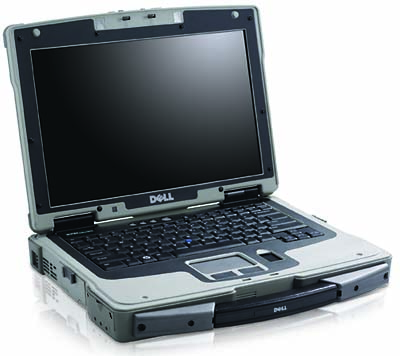Wow. Dell is getting serious about the rugged notebook market with the introduction of the Latitude XFR D630.
The original Dell Latitude ATG, introduced in January of 2007, was a fairly half-hearted effort, and with Dell not even clearly stating ruggedness specs, it was anyone's guess what exactly "All Terrain Grade" meant or how tough it was. In the summer of 2007, Augmentix — a privately held company headquartered in Austin, Texas — presented an entirely more serious effort. The Augmentix XTG630 was based on the Dell Latitude ATG, but it went considerably farther in ruggedizing the base Dell product. Then, in the fall of 2007, Dell introduced a second generation ATG, the Dell ATG D630. It still wasn't a truly rugged machine (even a shock-mounted hard drive was an extra-cost option!), but we did a very detailed review (see review of Dell ATG D630) primarily because the machine came with Dell's new DirectVue display technology that offers superb outdoor viewability.

So now Dell offers the XFR D630. From what we can tell, it is essentially a slightly upgraded version of the Augmentix/Dell XTG630, which means it's for real. The XFR D630 is an 9-pound notebook (where does the extra pound of weight come from?) with a 13.9 x 10.2 inch footprint. It is 2.6 inches thick, has a 14.1-inch 1280 x 800 wide-format display that uses the superb DirectVue display enhancement that our technology editor, Geoff Walker, called the best currently available solution for a non-touchscreen outdoor viewability display. A touch screen is available as well as a $500 option.
The XFR D630 can be equipped with either a Core 2 Duo T7250 (2.0 GHz) or a T7500 (2.2GHz) processor and with up to 4GB of 667MHz DDR2 RAM. The 1.8-inch 80GB hard disk is shock mounted and isolated. A second one can be placed in the machine's modular media bay. If ruggedness, speed and longevity are essential and cost not an issue, Dell also offers a 32GB ($210) or 64GB ($509) solid state drive.
 Unlike some rugged machines, the XFR D630 offers superb connectivity and expandability. There are four USB ports, serial, IEEE1394 "Firewire," LAN, modem, audio and video and a docking connector, all tightly sealed. There is a PC Card slot that also supports 34mm ExpressCards. The modular X-Bay media bay can accommodate all sorts of optical drives, the above-mentioned second hard disk, or a second battery (Li-Polymer), a floppy drive or more.
Unlike some rugged machines, the XFR D630 offers superb connectivity and expandability. There are four USB ports, serial, IEEE1394 "Firewire," LAN, modem, audio and video and a docking connector, all tightly sealed. There is a PC Card slot that also supports 34mm ExpressCards. The modular X-Bay media bay can accommodate all sorts of optical drives, the above-mentioned second hard disk, or a second battery (Li-Polymer), a floppy drive or more.
A whole array of tough materials are used to make the XFR D630 one of the most rugged notebooks available. There is a die-cast magnesium housing with internal structural framing support, polypropylene-composite elastomer overmolds and doors, reinforced fiberglass injected polycarbonate, stainess steel, die cast compression gaskets, and special saltwater-resistant paint and sealant. This results in the ability to survive 36 drops 3-foot drops in accordance with MIL-STD-810F 516.5, IV, IP54 sealing (dust and waterspray-proof), and an extremely wide operating temperature range of -20 to 140 degrees Fahrenheit. A proprietary "QuadCool" internal thermal management system keeps things cool, and Dell's vast experience in systems and components design provides superior reliability and economy.
On the communication side, there are various options including EDVO Rev A and HSDPA 3.6 Mobile Broadband, integrated 802.11a/g/n WiFi, Bluetooth Class 2 and GPS. For security, there is the SmartSecurity Suite with multi-factor authentication that includes an integrated smart card reader, biometrics fingerprint reader and multi-level passwords. TPM 1.2 provides added cryptographic functionality and the machine uses a multi-level security suite to protect agianst unauthorized access.
And what's the price? A base XFR starts at $3,899 (and that now includes a shock-mounted hard drive), but a fully-optioned one with a touch screen approaches $6,000. That's a lot compared to a consumer notebook, but entirely in line for a rugged machine in this class.
The primary selling point, however, is that this is a Dell, and as a Dell it'll fit right into the existing IT infrastructure of Dell notebooks in all sorts of oganizations.
Dell also seems to have taken a crash course in how to present and sell rugged machines. Whereas the initial efforts lacked both ruggedness and decipherable ruggedness certification data, Dell now provides a very detailed description of all the independent testing and validation performed on the machine. The tests are listed, described and explained. That is a big step forward and makes it easier for customers to determine if and how the XFR D630 fits their needs.



